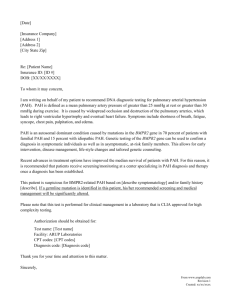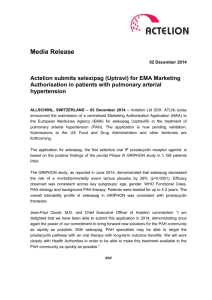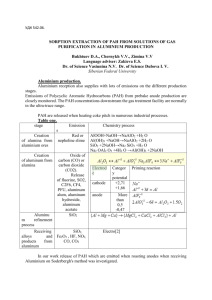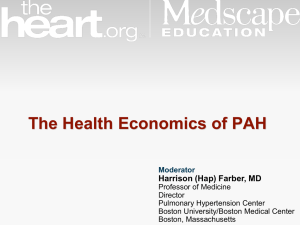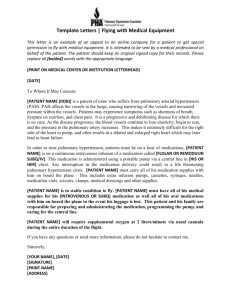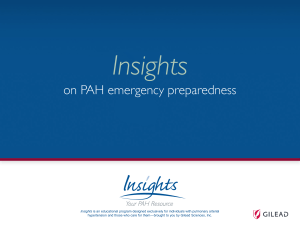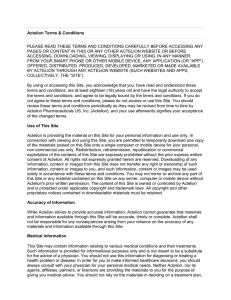Media Release English
advertisement
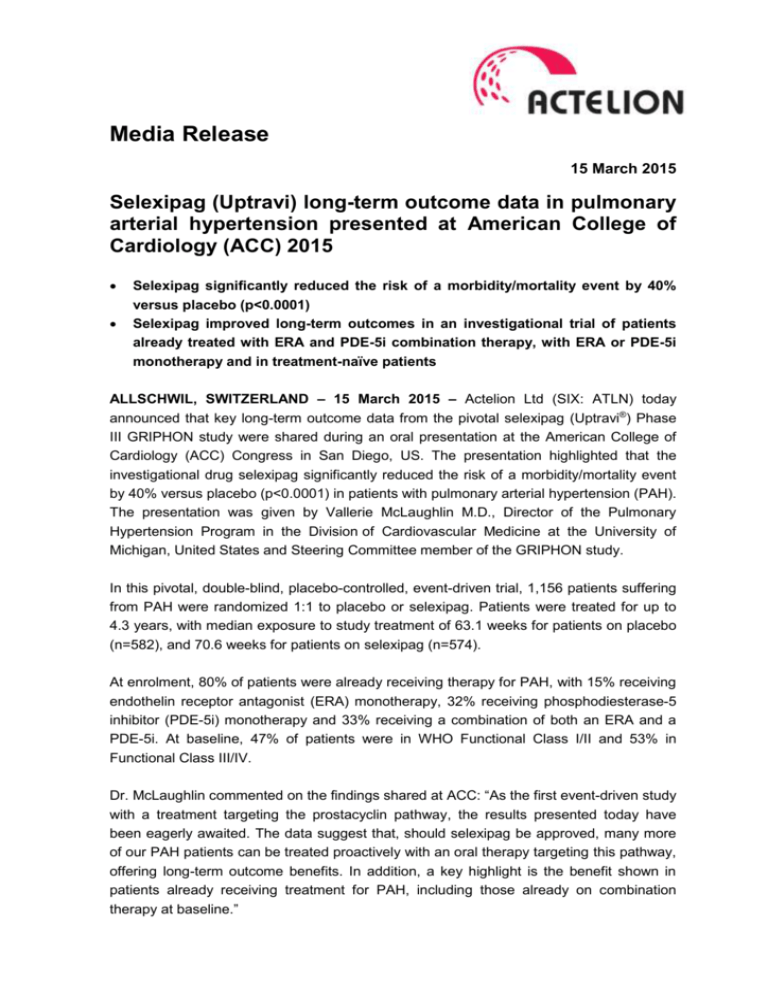
Page 1 of 5 Media Release 15 March 2015 Selexipag (Uptravi) long-term outcome data in pulmonary arterial hypertension presented at American College of Cardiology (ACC) 2015 Selexipag significantly reduced the risk of a morbidity/mortality event by 40% versus placebo (p<0.0001) Selexipag improved long-term outcomes in an investigational trial of patients already treated with ERA and PDE-5i combination therapy, with ERA or PDE-5i monotherapy and in treatment-naïve patients ALLSCHWIL, SWITZERLAND – 15 March 2015 – Actelion Ltd (SIX: ATLN) today announced that key long-term outcome data from the pivotal selexipag (Uptravi®) Phase III GRIPHON study were shared during an oral presentation at the American College of Cardiology (ACC) Congress in San Diego, US. The presentation highlighted that the investigational drug selexipag significantly reduced the risk of a morbidity/mortality event by 40% versus placebo (p<0.0001) in patients with pulmonary arterial hypertension (PAH). The presentation was given by Vallerie McLaughlin M.D., Director of the Pulmonary Hypertension Program in the Division of Cardiovascular Medicine at the University of Michigan, United States and Steering Committee member of the GRIPHON study. In this pivotal, double-blind, placebo-controlled, event-driven trial, 1,156 patients suffering from PAH were randomized 1:1 to placebo or selexipag. Patients were treated for up to 4.3 years, with median exposure to study treatment of 63.1 weeks for patients on placebo (n=582), and 70.6 weeks for patients on selexipag (n=574). At enrolment, 80% of patients were already receiving therapy for PAH, with 15% receiving endothelin receptor antagonist (ERA) monotherapy, 32% receiving phosphodiesterase-5 inhibitor (PDE-5i) monotherapy and 33% receiving a combination of both an ERA and a PDE-5i. At baseline, 47% of patients were in WHO Functional Class I/II and 53% in Functional Class III/IV. Dr. McLaughlin commented on the findings shared at ACC: “As the first event-driven study with a treatment targeting the prostacyclin pathway, the results presented today have been eagerly awaited. The data suggest that, should selexipag be approved, many more of our PAH patients can be treated proactively with an oral therapy targeting this pathway, offering long-term outcome benefits. In addition, a key highlight is the benefit shown in patients already receiving treatment for PAH, including those already on combination therapy at baseline.” CONSISTENT KEY SUBGROUP FINDINGS The reduction in risk of a morbidity/mortality event was consistent across key subgroups; age, gender, PAH etiology, baseline WHO Functional Class and irrespective of background therapy, including patients receiving selexipag on top of a combination of both an ERA and a PDE-5i. DOSING IN GRIPHON Titrating selexipag to an individualized maintenance dose based on tolerability was effective in achieving long-term outcome benefits across the tested dose range. The dosing in GRIPHON was initiated at 200 micrograms (mcg) twice daily (b.i.d) and increased weekly in steps of 200 mcg up to a maximum of 1600 mcg b.i.d. After titrating to the highest tolerated dose, the benefit was consistent across the pre-specified low- (200, 400 mcg b.i.d), medium- (600, 800, 1’000 mcg b.i.d) and high-maintenance (1’200, 1’400, 1’600 mcg b.i.d) dose groups. SIX-MINUTE WALK DISTANCE Treatment with selexipag also led to a statistically significant increase in six-minute walk distance (6MWD) at week 26 of 12 meters in the entire patient population (p=0.0027), with an improvement of 34 meters in PAH-treatment-naïve patients (p=0.0002). SAFETY AND TOLERABILITY Tolerability of selexipag in GRIPHON was consistent with therapies targeting the prostacyclin pathway. Adverse reactions occurring more frequently (>5%) on selexipag compared to placebo, over the course of the study, were headache, diarrhea, jaw pain, nausea, myalgia, vomiting, pain in extremity, and flushing. Over the course of the study, the proportion of patients discontinuing treatment due to adverse events, without a morbidity or mortality event, was 14% on selexipag and 7% on placebo. Further data from the GRIPHON study will be shared through scientific publication. ### Notes to Editor: SELEXIPAG AT ACC-15 Oral presentation: Effect of selexipag on morbidity/mortality in pulmonary arterial hypertension: results of the GRIPHON study. Vallerie V. McLaughlin (presenter), Richard Channick, Kelly Chin, Aline Frey, Sean Gaine, Ardeschir Ghofrani, Marius Hoeper, Irene Lang, Ralph Preiss, Lewis J. Rubin, Gérald Simonneau, Olivier Sitbon, Mylène Stefani, Victor Tapson, Nazzareno Galiè. March 15, 2015, 10:45–12:15pm. - Selexipag (Uptravi) long-term outcome data in PAH presented at ACC 2015 - 2 Poster presentation: The non-prostanoid prostacyclin receptor agonist ACT-333679, the active metabolite of selexipag, is characterized by low beta-arrestin recruitment and receptor internalization activitiy. John Gatfield, Katalin Menyhart, Keith Morrison, Oliver Nayler. March 14, 2015, 10:00–10:45am. Poster presentation: Repeated oral administration of the selective prostacyclin receptor agonist selexipag does not cause tachyphylaxis in spontaneously hypertensive rats. Keith Morrison, Daniel Wanner, John Gatfield, Carmela Gnerre, Patrick Hess, Martine Clozel. March 15, 2015, 3:45–4:30pm. REGULATORY STATUS OF SELEXIPAG In December 2014, Actelion submitted the registration dossier for selexipag to both Europe's EMA and the US FDA for the treatment of patients with PAH, where review is ongoing. Submission of the registration dossier to other Health Authorities is ongoing with regulatory review underway in Australia, Canada, New Zealand, and Switzerland. ABOUT SELEXIPAG [1,2,3,4] Selexipag, originally discovered and synthesized by Nippon Shinyaku, is a potent, orally available, selective IP prostacyclin receptor agonist. Selexipag and its major metabolite selectively target the prostacyclin receptor (also called IP receptor). The IP receptor is one of 5 major types of prostanoid receptor (IP, EP, DP, TP, FP). Prostacyclin activates the IP receptor to induce vasodilation and inhibit proliferation of vascular smooth muscle cells. Selexipag, is efficacious in preclinical disease models and has reduced potential for side effects mediated by activation of other prostanoid receptors, such as EP1 and EP3 receptors. Selexipag was previously evaluated in a Phase II, 43-patient, placebo-controlled, double-blind study, where patients were randomized in a 3:1 ratio receiving selexipag or placebo on top of PDE-5 inhibitor and/or ERA. ABOUT GRIPHON GRIPHON, (Prostacyclin (PGI2) Receptor agonist In Pulmonary arterial HypertensiON) was a randomized, multicenter, double-blind, placebo-controlled trial evaluating the long term efficacy and safety of oral selexipag in patients with PAH. The GRIPHON study was the largest randomized, controlled, outcome trial ever conducted in PAH patient population, enrolling 1,156 patients in 181 centers from 39 countries in North and Latin America, Europe, AsiaPacific and Africa. Patients received twice daily administration of selexipag or placebo and were also permitted to receive background PAH-specific therapy of an endothelin receptor antagonist and/or a phosphodiesterase-5 inhibitor when on a stable dose for at least 3 months prior to enrollment. At baseline, 80% of patients were receiving oral medication specific for PAH: either an ERA, a PDE-5 inhibitor, or a combination of the two. This pivotal, event-driven study was designed to demonstrate a prolongation of time to the first morbidity/mortality event for selexipag compared to placebo and to evaluate the safety profile of selexipag in PAH patients. All morbidity and mortality events reported by the investigators were adjudicated by an independent Critical Event Committee blinded to the study treatment. - Selexipag (Uptravi) long-term outcome data in PAH presented at ACC 2015 - 3 THE ROLE OF THE PROSTACYCLIN PATHWAY [5] The prostacyclin pathway is one of the 3 essential pathways involved in the pathophysiology and treatment of PAH. Prostacyclin is a prostanoid and serves as a signaling molecule in the human body. It is produced, like other vasoactive substances, by endothelial cells. Prostacyclin induces vasodilation, is anti-proliferative, has anti-inflammatory effects and inhibits platelet aggregation. In certain disease conditions, the production of prostacyclin by the endothelium is impaired, allowing for example, the deleterious effects of excessive levels of endothelin or thromboxane to predominate. PULMONARY ARTERIAL HYPERTENSION (PAH) PAH is a chronic, life-threatening disorder characterized by abnormally high blood pressure in the arteries between the heart and lungs of an affected individual. The symptoms of PAH are non-specific and can range from mild breathlessness and fatigue during normal daily activity to symptoms of right heart failure and severe restrictions on exercise capacity and ultimately reduced life expectancy. PAH is one group within the classification of pulmonary hypertension (PH). This group includes idiopathic PAH, heritable PAH and PAH caused by factors which include connective tissue disease, HIV infection and congenital heart disease. The last decade has seen significant advances in the understanding of the pathophysiology of PAH, which has been paralleled with developments of treatment guidelines and new therapies. Drugs targeting the three pathways that have been established in the pathogenesis of PAH are endothelin receptor antagonists (ERAs), prostacyclin analogs and phosphodiesterase-5 inhibitors. PAH treatments have transformed the prognosis for PAH patients from symptomatic improvements in exercise tolerance 10 years ago to delayed disease progression today. Improved disease awareness and evidence-based guidelines developed from randomized controlled clinical trial data have highlighted the need for early intervention, goal-oriented treatment and combination therapy. ABOUT THE ACTELION / NIPPON SHINYAKU ALLIANCE Actelion and Nippon Shinyaku entered into an exclusive worldwide alliance in April 2008 to collaborate on selexipag, a first orally-available, selective prostacyclin IP receptor agonist for patients suffering from PAH. This compound was originally discovered and synthesized by Nippon Shinyaku. Actelion is responsible for global development and commercialization of selexipag outside Japan, while the two companies will codevelop and co-commercialize in Japan. Nippon Shinyaku will receive milestone payments based on development stage and sales milestones as well as royalties on any sales of selexipag. References 1. Kuwano et al. A long-acting and highly selective prostacyclin receptor agonist prodrug, NS-304, ameliorates rat pulmonary hypertension with unique relaxant responses of its active form MRE-269 on rat pulmonary artery. J Pharmacol Exp Ther 2008;326:691-699. 2. Mubarak KK. A review of prostaglandin analogs in the management of patients with pulmonary arterial hypertension. Respir Med 2010;104:9-21.Morrison et al. Selexipag: a selective prostacyclin receptor agonist that does not affect rat gastric function. J Pharmacol Exp Ther 2010;335:249-255. 3. Morrison et al. Differential effects of selexipag and prostacyclin analogs in rat pulmonary artery. J Pharmacol Exp Ther 2012;343:547-555. 4. Simonneau G, Lang I, Torbicki A, Hoeper MM, Delcroix M, Karlocai K, Galie N. Selexipag, an oral, selective IP receptor agonist for the treatment of pulmonary arterial hypertension Eur Respir J 2012; 40: 874-880. 5. Mubarak KK. A review of prostaglandin analogs in the management of patients with pulmonary arterial hypertension. Respir Med 2010;104:9-21. - Selexipag (Uptravi) long-term outcome data in PAH presented at ACC 2015 - 4 Dr. McLaughlin is a consultant to Actelion NIPPON SHINYAKU For further information on Nippon Shinyaku please visit: http://www.nippon-shinyaku.co.jp/english/index.html ACTELION LTD Actelion Ltd. is a leading biopharmaceutical company focused on the discovery, development and commercialization of innovative drugs for diseases with significant unmet medical needs. Actelion is a leader in the field of pulmonary arterial hypertension (PAH). Our portfolio of PAH treatments covers the spectrum of disease, from WHO Functional Class (FC) II through to FC IV, with oral, inhaled and intravenous medications. Although not available in all countries, Actelion has treatments approved by health authorities for a number of specialist diseases including Type 1 Gaucher disease, Niemann-Pick type C disease, Digital Ulcers in patients suffering from systemic sclerosis, and mycosis fungoides type cutaneous Tcell lymphoma. Founded in late 1997, with now over 2,400 dedicated professionals covering all key markets around the world including Europe, the US, Japan, China, Russia and Mexico, Actelion has its corporate headquarters in Allschwil / Basel, Switzerland. Actelion shares are traded on the SIX Swiss Exchange (ticker symbol: ATLN) as part of the Swiss blue-chip index SMI (Swiss Market Index SMI®). All trademarks are legally protected. For further information please contact: Andrew C. Weiss Senior Vice President, Head of Investor Relations & Corporate Communications Actelion Pharmaceuticals Ltd, Gewerbestrasse 16, CH-4123 Allschwil +41 61 565 62 62 http://www.actelion.com The above information contains certain "forward-looking statements", relating to the company's business, which can be identified by the use of forward-looking terminology such as "estimates", "believes", "expects", "may", "are expected to", "will", "will continue", "should", "would be", "seeks", "pending" or "anticipates" or similar expressions, or by discussions of strategy, plans or intentions. Such statements include descriptions of the company's investment and research and development programs and anticipated expenditures in connection therewith, descriptions of new products expected to be introduced by the company and anticipated customer demand for such products and products in the company's existing portfolio. Such statements reflect the current views of the company with respect to future events and are subject to certain risks, uncertainties and assumptions. Many factors could cause the actual results, performance or achievements of the company to be materially different from any future results, performances or achievements that may be expressed or implied by such forward-looking statements. Should one or more of these risks or uncertainties materialize, or should underlying assumptions prove incorrect, actual results may vary materially from those described herein as anticipated, believed, estimated or expected. - Selexipag (Uptravi) long-term outcome data in PAH presented at ACC 2015 - 5

